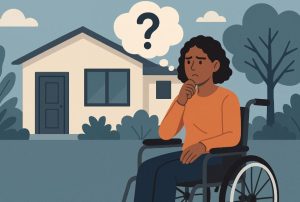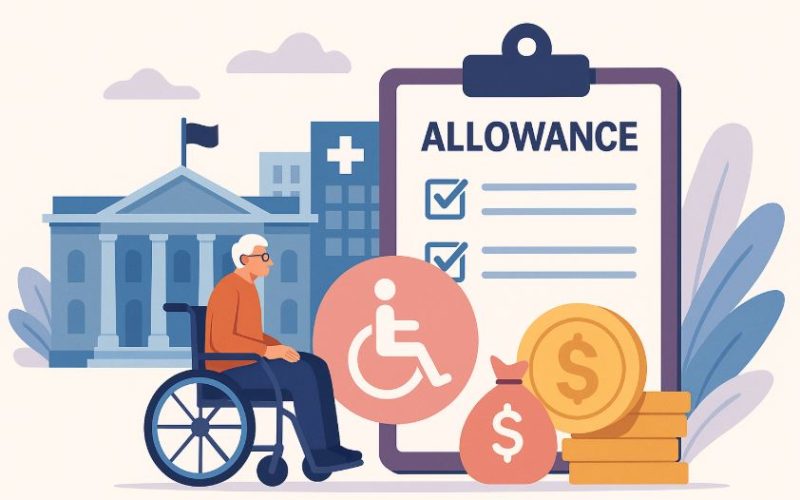Have you ever wondered whether Severe Disablement Allowance (SDA) is still active in 2025? Many individuals who were previously unable to work due to long-term illness or disability relied on this support.
This blog explores the current state of Severe Disablement Allowance, who may still qualify, what happens during reassessment, how it interacts with other benefits like Employment and Support Allowance (ESA), and how to navigate changes in eligibility.
Whether you are a recipient or supporting someone who is, this guide will break down everything you need to know.
Let’s begin by understanding the origins and evolution of this discontinued but still relevant benefit.
What Is Severe Disablement Allowance?

Severe Disablement Allowance (SDA) was a UK government benefit introduced to support individuals who were unable to work due to long-term illness or significant disability.
Designed as a non-contributory benefit, it targeted individuals who had not paid enough National Insurance contributions to qualify for other forms of incapacity support.
Historical Context
SDA served as a financial lifeline for thousands from its introduction until its replacement in 2001 by Incapacity Benefit, and later by Employment and Support Allowance (ESA).
Despite no longer accepting new applications, the Department for Work and Pensions (DWP) still continues to support individuals who started receiving it before the changes took place and have not yet transitioned to ESA.
Original Eligibility Criteria
Applicants could qualify for SDA if they:
- Were aged between 16 and 64
- Had been incapable of work due to illness or disability for at least 28 weeks in a row
- Were assessed as being at least 80% disabled
These criteria were assessed through a medical examination and supporting documentation.
Purpose
The main goal of SDA was to offer financial assistance to those who were excluded from contributory benefits due to insufficient National Insurance history. It helped bridge the gap for individuals facing severe long-term health conditions who needed state support.
What Has Replaced Severe Disablement Allowance In The UK?
Today, Severe Disablement Allowance has been fully replaced by Employment and Support Allowance (ESA). This modern benefit is designed to support individuals with limited capability to work due to health conditions or disabilities.
Timeline of Replacement
- 2001: SDA was closed to new applicants and replaced by Incapacity Benefit.
- 2008: Incapacity Benefit began phasing out and was replaced by ESA.
- Ongoing: SDA recipients under pension age are now being reassessed for a transfer to ESA.
Why Was SDA Replaced?
SDA was replaced to streamline the welfare system and integrate health capability assessments under a unified scheme. ESA introduced a more detailed assessment framework and tailored support plans to help those capable of some form of work to re-engage with employment.
Important Note for Claimants
If you’re still receiving SDA and have not reached State Pension age, you may be moved to ESA after a reassessment. If you’ve already reached State Pension age, you can continue receiving SDA unless your circumstances change.
What Happens If You’re Still Receiving Severe Disablement Allowance?

Though new applications are no longer accepted, some people in the UK still receive SDA as a legacy benefit. The rules surrounding this ongoing support depend largely on your age and current circumstances.
Under State Pension Age
Those below State Pension age will be reassessed to determine if they should move to ESA. This is part of the government’s initiative to streamline benefit systems and ensure current eligibility aligns with new frameworks.
Over State Pension Age
If you’ve reached State Pension age, you will typically continue receiving SDA, unless your circumstances change. These changes might include:
- Changes in health status
- Entering into work beyond permitted limits
- Moving abroad
How Does The Reassessment Process For SDA To ESA Work?
The reassessment process plays a crucial role in transitioning SDA recipients to ESA. It evaluates whether an individual still meets the conditions for limited work capability under the ESA framework.
What to Expect?
Questionnaire from Jobcentre Plus
Recipients receive a health questionnaire, asking detailed questions about how their disability or illness affects daily life. It is essential to return the form by the given deadline.
Medical Evidence
Supporting documents such as medical reports or letters from doctors must be submitted with the questionnaire. Originals are returned after review.
Face-to-Face Assessment
If further evaluation is required, claimants are asked to attend a Work Capability Assessment. This in-person session helps determine the individual’s ability to perform work-related tasks.
Outcomes of Reassessment
| Assessment Outcome | What Happens Next? |
| Deemed fit for work | SDA is stopped; claimant may be advised to apply for Jobseeker’s Allowance |
| Deemed not fit for work | Transferred to ESA automatically |
It’s important to cooperate with this process, as non-compliance can result in payment suspension or termination.
How To Claim Severe Disablement Allowance If You’re Still Eligible?

While new SDA claims are not accepted, existing recipients may wonder how to continue receiving the allowance or what to do during a reassessment.
Key Points for Existing Claimants
- No new applications: SDA is closed for new applicants.
- Review process: Existing claimants are subject to periodic reviews.
- Transfer pathway: If under State Pension age, you may be moved to ESA following an assessment.
Actions You Must Take
- Keep Jobcentre Plus informed about any change in your circumstances
- Respond promptly to all correspondence related to SDA or ESA transitions
- Attend medical assessments when requested
This ensures you remain compliant and do not risk having your benefits reduced or stopped.
What Work Is Allowed While Receiving Severe Disablement Allowance?
Engaging in some forms of work while on SDA is permitted under specific rules. This is known as Permitted Work.
What Qualifies as Permitted Work?
You can continue receiving SDA if your work falls into these categories:
- Voluntary work
- Paid work under 16 hours per week on average
- Earnings do not exceed £95.50 per week
Special Work Situations
Work may also be allowed if:
- It’s part of a treatment or rehabilitation programme
- It’s supervised by a health or community worker
- The recipient is exempt from a Personal Capability Assessment
Reporting Permitted Work
Even if work qualifies under permitted rules, it must be reported to Jobcentre Plus. Failing to do so can result in benefit overpayments or sanctions.
What Should You Do If Your Circumstances Change While On SDA?

Changes in your personal or financial circumstances can affect your SDA entitlement. It’s your responsibility to notify the Jobcentre Plus office handling your claim.
Examples of Changes to Report
- Starting or stopping any form of work
- Change in income
- Moving in with a partner
- New health condition or improvement
Why Reporting Matters?
Timely updates prevent overpayments or disruptions to your benefit. It also ensures that if your condition worsens, you receive the correct level of support under ESA or other benefits.
How Does The Benefit Cap Affect SDA Claimants?
The UK’s benefit cap is a limit on the total amount of benefits a person can receive. It affects people of working age and can impact SDA claimants, especially those receiving additional support.
Who Is Affected?
- Individuals aged 16 or over but under State Pension age
- Households receiving multiple benefits
Exemptions from the Benefit Cap
Some benefits are excluded from the cap, such as:
- Personal Independence Payment (PIP)
- Attendance Allowance
- Employment and Support Allowance (if in the support group)
Always check with a benefits advisor to see if your household falls under the cap or is exempt.
What Are Disability Premiums And How Are They Linked To SDA?
Disability premiums are extra amounts added to certain benefits for people with disabilities. They help increase income support for those on low income with long-term health conditions.
Types of Premiums
| Premium Type | Key Eligibility |
| Disability Premium | DLA, PIP, ADP, AFIP or blindness |
| Severe Disability Premium | Live alone, no carer claiming Carer’s Allowance |
| Enhanced Disability Premium | High rate PIP, DLA or in ESA support group |
Linked Benefits
Disability premiums can be added to:
- Income Support
- Income-based Jobseeker’s Allowance
- Income-related ESA
- Housing Benefit
These premiums are especially important for SDA recipients transitioning to ESA, as they may increase total entitlement.
What Are The Conditions For Receiving A Severe Disability Premium?
To receive the Severe Disability Premium (SDP), several conditions must be met. It provides extra financial help for those with significant care needs.
Eligibility Criteria
You must:
- Receive a qualifying disability benefit such as PIP daily living component or Attendance Allowance
- Live alone or be treated as living alone
- Not have someone claiming Carer’s Allowance or Carer Support Payment for looking after you
Special Rules for Couples
If both partners are eligible, the higher amount of SDP is paid. If only one qualifies or is being cared for, the lower amount is provided.
Exclusions
You cannot get SDP if someone receives Carer’s Allowance for helping you. It is important to ensure your household situation aligns with eligibility rules.
Conclusion
Although Severe Disablement Allowance is no longer available for new claims, it remains an essential part of the UK’s legacy welfare system. Many still rely on this support, and understanding how it interacts with modern benefits like ESA ensures claimants receive the help they need.
From reassessments and permitted work to disability premiums and benefit caps, staying informed is the key to maintaining support. If you or someone you know is receiving SDA, proactive communication with Jobcentre Plus and awareness of benefit changes can make all the difference.
FAQs About Severe Disablement Allowance
Can I Still Apply for Severe Disablement Allowance in 2025?
No, new claims are not accepted. Only individuals already receiving SDA before its closure can continue receiving it.
What Is the Maximum Income Allowed Under Permitted Work?
You can earn up to £95.50 per week under permitted work rules while keeping your SDA.
Do I Need to Attend a Medical for Reassessment?
Yes, if required. You’ll be informed by Jobcentre Plus if a face-to-face Work Capability Assessment is needed.
What Happens If I Don’t Return the Reassessment Form?
Failing to return the questionnaire may result in your SDA payments being stopped.
Is SDA Affected by the Benefit Cap?
Yes, SDA may be affected if you receive multiple benefits, unless you qualify for an exemption.
Can I Get Severe Disability Premium While on SDA?
You may qualify if you meet specific conditions including receiving a qualifying disability benefit and living alone.
What Happens If My Partner Also Qualifies for SDP?
If both you and your partner qualify, you may receive the higher rate of the Severe Disability Premium.









